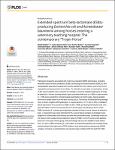Extended-spectrum beta-lactamase (ESBL)-producing Escherichia coli and Acinetobacter baumannii among horses entering a veterinary teaching hospital: The contemporary "Trojan Horse"
Walther, Birgit
Klein, Katja-Sophia
Barton, Ann-Kristin
Semmler, Torsten
Huber, Charlotte
Wolf, Silver Anthony
Tedin, Karsten
Merle, Roswitha
Mitrach, Franziska
Guenther, Sebastian
Lübke-Becker, Antina
Gehlen, Heidrun
Pathogens frequently associated with multi-drug resistant (MDR) phenotypes, including extended-spectrum beta-lactamase (ESBL)-producing Enterobacteriaceae (ESBL-E) and Acinetobacter baumannii isolated from horses admitted to horse clinics, pose a risk for animal patients and personnel in horse clinics. To estimate current rates of colonization, a total of 341 equine patients were screened for carriage of zoonotic indicator pathogens at hospital admission. Horses showing clinical signs associated with colic (n = 233) or open wounds (n = 108) were selected for microbiological examination of nostril swabs, faecal samples and wound swabs taken from the open wound group. The results showed alarming carriage rates of Gram-negative MDR pathogens in equine patients: 10.7% (34 of 318) of validated faecal specimens were positive for ESBL-E (94%: ESBL-producing Escherichia coli), with recorded rates of 10.5% for the colic and 11% for the open wound group. 92.7% of the ESBL-producing E. coli were phenotypically resistant to three or more classes of antimicrobials. A. baumannii was rarely detected (0.9%), and all faecal samples investigated were negative for Salmonella, both directly and after two enrichment steps. Screening results for the equine nostril swabs showed detection rates for ESBL-E of 3.4% among colic patients and 0.9% in the open wound group, with an average rate of 2.6% (9/340) for both indications. For all 41 ESBL-producing E. coli isolated, a broad heterogeneity was revealed using pulsed-field gel electrophoresis (PFGE) patterns and whole genome sequencing (WGS) -analysis. However, a predominance of sequence type complex (STC)10 and STC1250 was observed, including several novel STs. The most common genes associated with ESBL-production were identified as blaCTX-M-1 (31/41; 75.6%) and blaSHV-12 (24.4%). The results of this study reveal a disturbingly large fraction of multi-drug resistant and ESBL-producing E. coli among equine patients, posing a clear threat to established hygiene management systems and work-place safety of veterinary staff in horse clinics.
Dateien zu dieser Publikation
Keine Lizenzangabe

